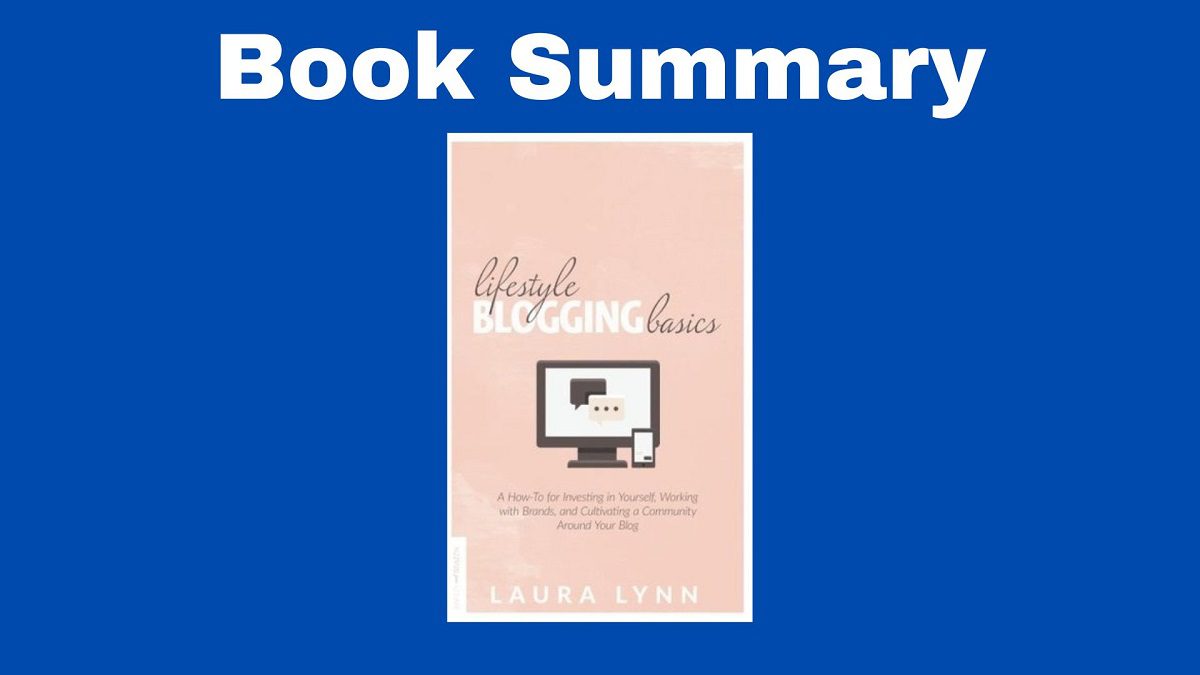The Book in Three Sentences
In this short how-to guide, you’ll learn the basics of blogging so that you can discover your niche, choose a name for your blog, select a platform, and create a blogging routine that makes sense for you. There’s a lot to help you maximize your blogging experience in this book. The conversational tone makes the book easy to read, even in the how-to sections when it covers basic concepts.
Lifestyle Blogging Basics Summary
Chapter 1: My Starting Out Story
Laura Lynn is a lifestyle blogger who started her journey in 2008. Blogging consistently allowed her to have a small and growing audience and she eventually landed a job as a product development manager where she works on courses and educational products. She wants this book to be a tool to share everything she learned.
Laura started her first blog out of sheer passion, but it lacked direction. She called the blogger site Human Behavior. Although the blog never became popular, it taught her the basics of the medium. Eventually, she started a more serious blog called Relatively Offbeat which she co-owned with her cousin Katelyn. The blog taught her the importance of accountability and consistency. Soon, brands started contacting them to collaborate, as well as local bloggers. The gig lasted two and a half years when Laura got another job. Her third blog is Breezy and Brazen which she started while living in Nashville.
Chapter 2: Getting Started
To start a blog:
- Decide on your content buckets: this is what your blog is about. To determine your content, think about your target audience. Try to make your content unique in order to stand out.
- Come up with your blog’s name: try to choose a name that fits the style of your blog. Pick a name you’re proud of and that you’re comfortable saying out loud. To come up with a name you like, identify the topics you’ll cover, brainstorm ideas, determine the blog’s tone, and combine words in creative ways.
- Choose a platform: some options include Blogger or WordPress.
- Buy a domain: you might have to make small changes to the name you originally wanted. Having your own domain gives you credibility, which makes your site memorable. Most names tend to be inexpensive.
- Create an email account: having a dedicated email address gives you a way to collaborate with others or communicate with brands. It also makes your blog look professional.
- Create a content calendar: this lets you plan what you’re going to be posting online. Choose the frequency at which you’re going to be posting articles. The ideal routine includes one post per week, but this depends on each blogger.
Chapter 3: Investing in Yourself
Creating a blog is a choice to invest in yourself and build a brand, but you should also consider investing in the following:
- Blog design: hiring a designer or buying a premium template.
- High-quality photos: having high-resolution pictures gives you credibility. Alternatively, you can purchase a camera, take pictures and edit them yourself.
- Continuing education: this involves conferences, workshops, summits, and events where you can learn from the best bloggers.
- Email marketing service: this is useful to start your mailing list, one of the most effective ways to reach your audience. Despite being time-consuming and requiring a lot of planning, this gives you another source of traffic.
Chapter 4: Working with Brands
A blog is a way to market yourself, so find your voice and use it. Being consistent with your brand means having a unique style and personality, you can do this by having a banner with the blog’s name and logo, as well as adding a short bio and photograph.
Partnerships and Collaborations
- Collaborating with brands can help you get more traffic and often includes additional compensation in the form of money, products, or store credit.
- When asked to review products, never compromise your opinions in exchange for anything. Always be honest with your audience. Never sell something you wouldn’t purchase.
- Product giveaways benefit you and the brand you promote.
- Brand features are a way to promote a brand through a post.
It’s important to respect deals when working with brands in order to pave the way for future collaborations. Also, keep communicating with them and respect deadlines.
Affiliate marketing involves working for brands and earning a commission from them.
Networking and connecting with like-minded bloggers in your industry is a great way to grow and learn from others too.
To grow your blog, create a media kit. This is a document you give to sponsors to tell them everything they need to know about you. A media kit has images (a photo of you, your blog’s logo, a screenshot of your home page), stats (subscribers, social media followers, page views, unique visitors), a short bio, and a blog description. Bigger blogs should also have a pricing kit that features the fees you charge for collaborating with brands.
Chapter 5: Social Media for Bloggers
Using social media to grow your following and collaborating with brands is called microblogging. To gain traction when sharing posts on social media, write catchy headlines, use the best photo from the post, and share at the right time.
This is what you should know about social media:
- Hashtags are keywords or keyphrases with no spaces in between and a pound sign (#) in front of them. This is a way of tagging a post and connecting with like-minded people. Some of the most popular social media sites include Instagram, Pinterest, Facebook, Twitter, and Snapchat.
- You can automate social media posts to go live at a specific time.
Chapter 6: Creating and Cultivating a Blog Community
Growing a blog is a collection of tips you’ve learned from others. Have a “Why” statement in order to have a sense of purpose. This is something the author learned from Simon Sinek’s Start with Why.
To build a community:
- Connect on social media
- Reciprocate (leave comments, send emails, share content, show support)
- Know other bloggers in real life
Chapter 7: Driving Traffic to Your Blog
Your blog needs to be like a business and understanding the basics of marketing to get people to visit your site and keep them engaged is important. To do so:
- Optimize posts through SEO
- Use social media
- Be consistent
- Engage with other bloggers
- Write guest posts on other blog posts




